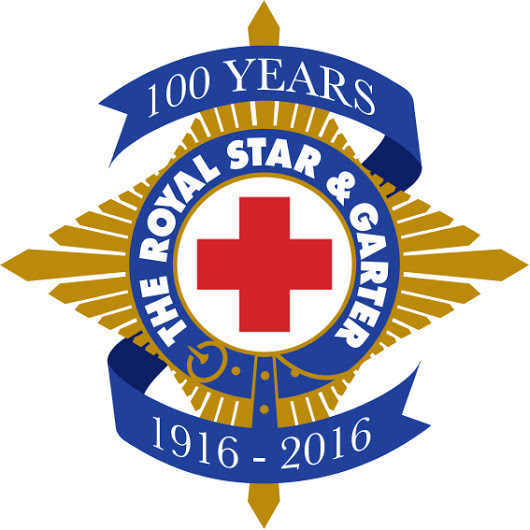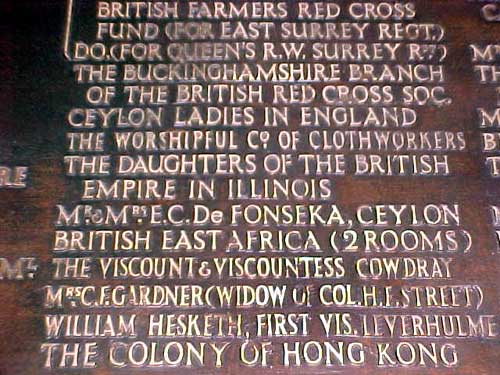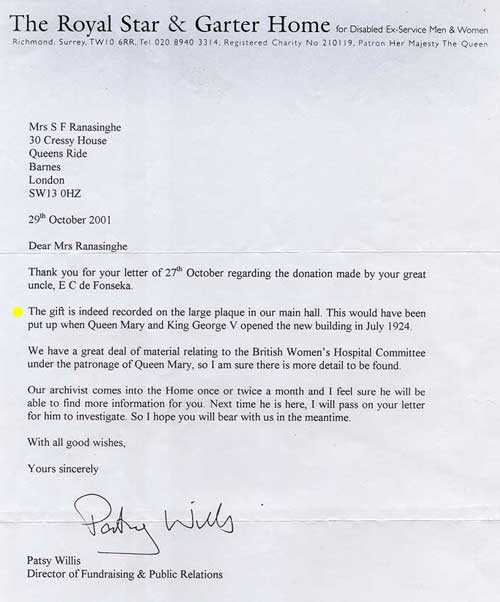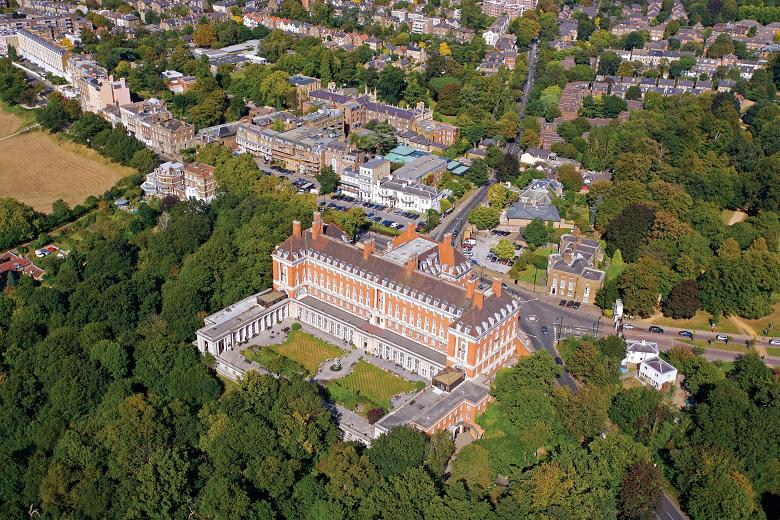 In 1922, the Star and Garter Home in Richmond-Upon-Thames, UK, was the beneficiary of a substantial donation from a Sri Lankan philanthropist, Edmund Clarke de Fonseka M.B.E.
In 1922, the Star and Garter Home in Richmond-Upon-Thames, UK, was the beneficiary of a substantial donation from a Sri Lankan philanthropist, Edmund Clarke de Fonseka M.B.E.
The Royal Star and Garter Home for Disabled Ex-Service men and women stands high on Richmond Hill in magnificent surroundings overlooking the river Thames. This unique home offers the best in nursing care and rehabilitation for anyone who is physically disabled or incapacitated and has served in Her Majesty’s Forces. The Home, which is a Grade II listed building, is situated at the top of Richmond Hill and enjoys spectacular views across the Thames and Richmond Park This home in far away Richmond, has a close connection with E. C. de Fonseka, who in 1922 made a substantial donation when the British Women’s Hospital Committee, launched a worldwide appeal for funds to build a permanent home for the Disabled Servicemen.
 The Royal Star & Garter Home was established as an independent charity in 1916 to care for the severely disabled young men returning from the battlegrounds of the First World War. It was Queen Mary who first expressed concern for the future of these young men, and Her Majesty charged the British Red Cross Society with the task of finding a “permanent haven” for them. At this time, the old Star & Garter Hotel on Richmond Hill was up for sale and had fallen into a state of dilapidation. On the 14th January 1916, the Star & Garter Home opened to admit the first 65 residents, who were accommodated in the converted old Star& Garter hotel’s ballroom and banqueting halls.
The Royal Star & Garter Home was established as an independent charity in 1916 to care for the severely disabled young men returning from the battlegrounds of the First World War. It was Queen Mary who first expressed concern for the future of these young men, and Her Majesty charged the British Red Cross Society with the task of finding a “permanent haven” for them. At this time, the old Star & Garter Hotel on Richmond Hill was up for sale and had fallen into a state of dilapidation. On the 14th January 1916, the Star & Garter Home opened to admit the first 65 residents, who were accommodated in the converted old Star& Garter hotel’s ballroom and banqueting halls.
It soon became clear that the old hotel was impractical as a long term home and it was, therefore, decided to demolish it and erect a new purpose built home. The British Women’s Hospital Committee launched a worldwide appeal for funds to build the new home, and they were remarkably successful, raising nearly £9 million in today’s terms.
E. C. de Fonseka was one of the few individual contributors to this appeal, and donated a large sum of money towards the home.
The Donation
E. C. de Fonseka’s magnanimous donation is to date remembered in the large plaque erected in the main hall of the home, known as the Marble Entrance Hall. The Home has confirmed this donation in 2001(3), and we are indebted to Patsy Willis, Director of Public Relations and Mr. Nigel Venus, the Archivist of the home for providing valuable information regarding the donation and photographs of the plaque. In 2018, the home digitized some of the record indexes. On tracing the possible documents and enquiring further on this donation, the home was able to trace and confirm the exact amount donated by E.C. De Fonseka.
With regards the index cards you mentioned, the archivist was unable to find mention of E C De Fonseka in these files. However, the charity’s annual reports (reference no. 8711/ZSA/) record that Mr and Mrs E C De Fonseka, Ceylon paid an endowment of £2,000 to build a room which was known as the ‘De Fonseka Room’. No rooms were mentioned in the annual reports before 1924, but it is listed as one of the rooms at that time and continued to be listed until at least 1939.
Andy Cole OBE
Chief Executive
The Royal Star & Garter Homes
Accordingly in addition to the plaque, a room had been named after Mr. and Mrs. E. C. de Fonseka. The archivist confirms that as per the rules employed at that time, for a room to have been named after them, the donation would have been 2000 pounds or in excess. An amount exceeding 2000 pounds in 1922 would have been a substantial amount today.
If you consider a donation of 2000 pounds made in 1922, it is worth more than 108,040 Sterling Pounds in today’s money, or approximately 23 million rupees as at 2017(5).
 |
 |
|
Mr. E. C De Fonseka |
 |
The plaque is made of wood and wrought iron and is crowned by the crest of the home. It measures about 8 feet tall by 4 feet and is a dull brown in color (also see photograph at bottom). The names numbering around 60 – 70, have been carved into the plaque. The plaque contains the headings name of the ward, endowed by and built by. These are found in three columns. The names De Fonseka, MR. & MRS. E. C. De Fonseka, Ceylon, Mr. & Mrs. E. C. De Fonseka appears under the respective headings. This inscription stands out amongst the list of names as he is one of the handful of individuals who has contributed towards the construction of a ward in the home. Most of the names in the plaque contain names of groups or associations from around the world. The wards are no longer known by name, and today they are simply referred to as room 1, room 7 etc. Two other names in this plaque contains references to Ceylon. These refer to donations made by the ‘Ceylon Ladies in England’ and ‘Women of Ceylon’.
The new home was opened on 10th July 1924 by King George V and Queen Mary and dedicated as the Women of the Empire’s Memorial of the Great War.
Richmond upon Thames, where the home is situated is one of the most attractive of the outer London boroughs, the only one that spans the River Thames. Richmond Park situated opposite the home, extends over some 2,360 acres, and is a heritage landscape of national importance. The Park was enclosed as a hunting park by Charles I in 1637 and still retains many ingredients of a medieval deer park. The area around Richmond Hill is also home to some of the well-known celebrities like David Beckham/Posh Spice and Jerry Hall.
Her Majesty Queen Elizabeth became the Home’s Patron in 1953 following the death of Queen Mary and Her Royal Highness Princess Alexandra was appointed President in 1964. The Home became The Royal Star & Garter Home in 1979. Even today the Royal Patronage is visible by the many visits made by the members of the Royal Family to the home.
In recognition of the charitable work he has undertaken, E. C. de Fonseka received a M.B.E (Civil) on the 3rd of June 1919.
E. C. – The Early Years
The E. C. de Fonseka story however begins in a much earlier period. He was born in Kalutara to the Elite Karava family of John Henry de Fonseka (Mohandiram). He spent his childhood in the ancestral home ‘Telford Lodge’, in Kalutara North and later qualified as a Proctor. The ‘Telford Wallauwa’ was demolished many years ago, and the premises is now occupied by buildings housing the Employee Trust Fund and the ‘Hightones’ Photographic Studio. Around 1890’s he got married to the only daughter of W. A. Fernando, a wealthy Plumbago Merchant of the era. W. A. Fernando was a Singhalese pioneer of the Plumbago industry, who setup as a merchant in this commodity in 1854. The production of Plumbago (graphite) was noted in Ceylon by John Knox as early as 1681 and is first recorded as an export in 1829. It was exceptional as being one of the few industries controlled by local Singhalese rather than foreign owners.
With the death of Mr. Fernando in 1901, E. C. took control of the business and rapidly expanded the business, diversifying into plantations and invested heavily in crown land suitable for plantations. By 1922, where he made the donation to the Home, he was one of the richest men in the country and owned plantations and properties at Rosmead Place (then Browning Place) and Jawatta. He also owned some prime mines in Hikgaha and Makoluwewa (Kurunegala), Goluwanmulle (Galle) and Himbutamulle (Colombo) and also owned his own transport fleet of carts to transport the produce to the railways, and from the railways to his stores at Rosmead Place and Jawatta. By 1927 he owned 8,741 acres of plantation lands and was the third largest plantation owner in Ceylon. This is, as per a compilation of land use done by Michael Roberts from an analysis of the Ferguson’s Ceylon Directory of the same year (1). If one excludes the 17,000 acres held by A. J. Vanderpoorten ( a Eurasian ), E. C. was second only to R. E. S. de Soysa (9,368 acres), in the acreage held in plantations. In 1922 E. C. was also appointed to the Colombo Port Commission. (2)
The fortunes of E. C. changed dramatically with the collapse of the Graphite Industry and a general downturn in the demand for rubber. His extensive landholdings in plantations and prime properties, horses and other assets were gradually sold, some as late as the 1940’s. This was just before an upsurge in the rubber prices, due to demands created by the second world war. The last of the ‘Arcadia’ premises (his palatial residence down Alexandra Place) was blocked and sold in the late 70’s, and today only the part of the property that housed the stables, remain with the family (see separate story).
Richmond and Kalutara:
E. C. was born and spent his early years in Kalutara. Giving a strange twist to the story is the fact that, E. C.’s hometown of Kalutara was also at times referred to as the “Richmond” of Ceylon. The following paragraph drawing close parallels between them appear in the book 20th Century Impressions of Ceylon (page 641)(3).
“Kalutara has sometimes been called “the Richmond of Ceylon”. Parallels of this kind are often amusing, and sometimes irritating; and in this instance more than ordinary violence has been done to artistic truth by comparing this Ceylonese town at the mouth of a great tropical river with the bustling outpost of London, which is built about the “Silvery Thames”, at this point a sluggish, winding fresh-water stream. Still it may be admitted that Kalutara is beautifully situated. A long bar intercepts the flow of the river to the sea, and the stream widens out into what to the eye appears to be a considerable lake. The banks of this expense are covered with tropical vegetation, and the whole scene is much attractive. The view up-river is particularly fine, especially on a clear day, when Adam’s Peak shows up in imposing outline in the background.”
Apart from the comparison of the ‘Silvery Thames’ and the tropical river that is the ‘Kalu Ganga’, the author may not have dreamt that a decade and a half later, a son of Kalutara will be associated with one of the greatest landmarks of Richmond-Upon-Thames, the Star and Garter Home. Kalutara also became home to the ‘Richmond Castle, a palatial house built by L. N. Silva, another Plumbago merchant of that era.
THE ROYAL STAR & GARTER HOME is situated at Richmond, Surrey, TW10 6RR.
TEL: 020-8940-3314 For more information visit their Web Site – www.starandgarter.org.
UPDATE – The Present
With th e dwindling no of veterans and the average age of the residents going up to 88, the Star and Garter Homes needed smaller specialized facilities to provide care and support. Against this backdrop of increasing need and the mounting costs associated with maintaining and operating a Grade II building, the Charity decided to dispose the property and build three new care homes around the country, where residents can be cared for closer to their families.
e dwindling no of veterans and the average age of the residents going up to 88, the Star and Garter Homes needed smaller specialized facilities to provide care and support. Against this backdrop of increasing need and the mounting costs associated with maintaining and operating a Grade II building, the Charity decided to dispose the property and build three new care homes around the country, where residents can be cared for closer to their families.
The Richmond building was sold in November 2014 and a new generation of modern, award-winning homes now provides care appropriate for the veterans.
The property was acquired by London Square, a company established in 2010, which exclusively focus on the London residential property market. The Grade II Listed landmark building was meticulously refurbished to provide a stunning range of luxury apartments. The apartments were marketed from 2.45 million pounds each.
On enquiry in 2018 August, the company confirmed that as it is a Grade II listed building, all historically significant items such as the plaque, has been left untouched during the restoration, in their original locations.
Reference:
(1) Caste Conflict and Elite Formation – Michael Roberts 1982.
(2) Ceylon Civil List, 1922.
(3) 20th Century Impressions, Arnold Wright 1910.
(4) Letter from the Director Fundraising and Public Relations, Royal Star & Garter Home and other correspondence with the home (2001).
(5) Email from the Chief Executive, Andy Cole O.B.E (2018)
(6) The equivalent value of the donation was computed by using a program, which can calculate what an amount of money from sometime in the past, is worth in today’s terms. It was then multiplied by 213, the Sterling Pound Exchange Rate as at end August 2018 to arrive at the Rupee equivalent. The calculations are based on the Retail Price Index (RPI). This computation is done in the very same way using the very same data that economists and statisticians employ regularly. Indices of inflation fail to take proper account of improvements in quality. Even in the essentials of life there are significant changes over the years. Therefore over long time spans, changes in prices give only the very roughest and most approximate idea of changes in the value of money. You too can use the following link from the ‘Bank of England’ web site to do your own computations. https://www.bankofengland.co.uk/monetary-policy/inflation/inflation-calculator
Photographs: Photographs of the plaque courtesy of Nigel Venus, archivist Royal S & G Home, 2001.

